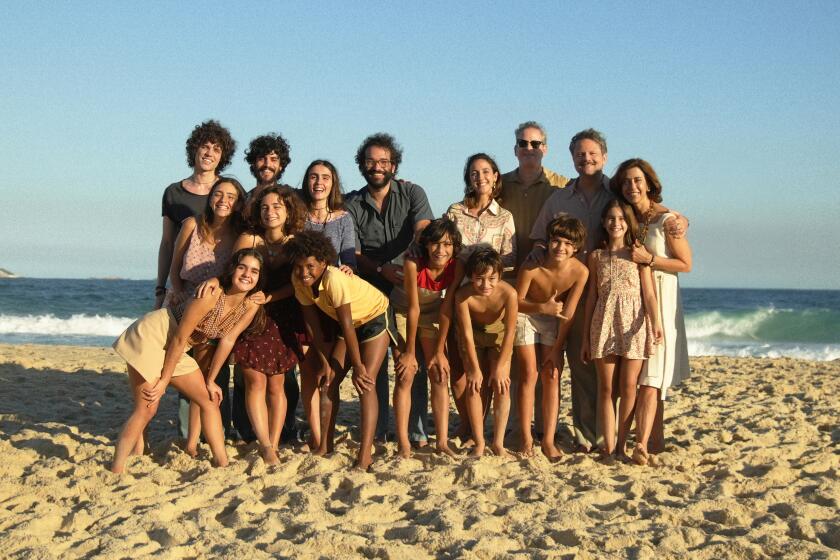
- Share via
Pablo Larraín practically sings when he talks about music. He was listening to John Coltrane on his walk over to the Beverly Hills Four Seasons to chat with The Envelope — he’s on a Coltrane kick — and lately he’s also been enjoying French prog-rock band Magma, opera singer Jessye Norman and some new interpretations of various classical masterworks.
He picks up his AirPods case and says: “This is the most important weapon that I have.”
The Chilean director of “Maria,” which stars Angelina Jolie as opera singer Maria Callas, is clearly a well-versed lover of cinema — but he says he wouldn’t actually consider himself a true cinephile.
‘We’re both very emotional women who probably are seen as quite strong but are quite vulnerable, emotional artists who are alone a lot,’ the actor says of herself and opera diva Maria Callas.
“I think I know more about music than movies,” he says. “It’s my life. Music, for me, is the most beautiful and poetic expression that humans have created. I have this fascination toward the exercise of music as the ultimate poetic act.”
This was, in part, what drew him to making a prismatic study of Callas. His previous two films in English, “Jackie” and “Spencer,” similarly explored female icons of the 20th century, both also meditations on grief and the isolation of fame. Those films too were enlivened by music, in the idiosyncratic and remarkable scores by Mica Levi and Jonny Greenwood, respectively.
But Larraín made music — specifically opera — both the text and subtext of his third caged-bird portrait. With a screenplay by Steven Knight (who also wrote “Spencer”), “Maria” trains a spotlight on the final “cycle” of the singer’s troubled life: her last week before she died in 1977. Flashbacks and montages of her girlhood and celebrity prime reveal fragments of her biography, but the movie mostly sifts through the singer’s insomniac and at times hallucinogenic hours wandering her palatial apartment and the streets of Paris to probe the mystery of Callas.
The film tries to take us as close as possible to the diva — Larraín literally shot much of it, operating the camera himself, within a foot or two of Jolie’s face — and inside her mind.
“One of the things that I love about movies, that I think we can do,” he says, “is to show someone’s relationship with reality.” In any given moment of our day, Larraín elaborates, we might be in the middle of a conversation with someone, but any stimuli around us might trigger an emotional memory of our mother, or our kids, or an event from our past.
“Our perception with reality is so fabulous,” says the director, 48, who still lives in Chile with his two teenage children.
Larraín read nine books about Callas, watched every documentary and interview he could find, and after all of that “I had no idea who she was,” he admits. “It’s an enormous amount of mystery — and I’m so drawn to that.”
Choosing her final week, “just one brick of that huge wall of life,” was an attempt to “experience her work,” he says, “and look at her ghost, and try to understand certain things. But mostly it’s not a rational experience. It’s around something that is about to vanish. It’s an exercise of human poetry.”
Which is where music became all-important. As Callas glides from a conversation with her butler to an interview with an imaginary journalist to strained rehearsals with a patient pianist, the music of her past invades the narrative — sometimes in visually fantastical ways.
In one scene, Callas is walking past a theater and an orchestra materializes in the rain — and suddenly she’s in a scene from the second act of Puccini’s “Madama Butterfly.” Passersby become the humming choir from the scene in that opera where the main character, Cio-Cio-San, is longingly waiting for her American captain to return to Japan.
In the opera, “She’s trying to sleep,” Larraín explains. “So the people, the choir, come together to sing this very peaceful music for her to sleep — but she can’t.”
Every aria or opera selection was made with dramatic intention; Larraín says the soundtrack is “the hidden map” of the movie.
At another point in the film, Callas attempts to sing “O Mio Babbino Caro” — translated “Oh, My Dear Father,” from Puccini’s “Gianni Schicchi” — during a rehearsal. Callas “had a very particular relationship with her father, who was an absent figure in her life,” says Larraín. “And in that moment, when she tries to see the state of her voice, she chooses to think about her father.”
In ‘Maria,’ the film itself becomes an opera about the betrayal and manipulation of soprano Maria Callas, notes cinematographer Edward Lachman.
Originally, the director planned to include subtitles so the audience could understand this illuminating map, “but then it became such a rational exercise,” he says. “It was so distracting to read the subtitles — it was just taking all the emotion out. And opera is about an emotional transit.”
He’s counting on the audience to have a more “subliminal perception, that maybe music would transmit that without the words.”
While making the film, he often thought about conductor Tullio Serafin’s advice to Callas in case she ever lost track of where her character was in the story, emotionally or dramatically, while onstage: “Just follow the music.”
“I took that as a mantra,” Larraín says, “for the film, and for her.”
More to Read
From the Oscars to the Emmys.
Get the Envelope newsletter for exclusive awards season coverage, behind-the-scenes stories from the Envelope podcast and columnist Glenn Whipp’s must-read analysis.
You may occasionally receive promotional content from the Los Angeles Times.










